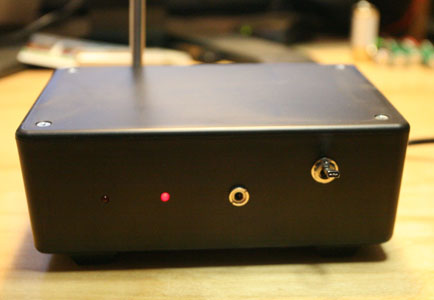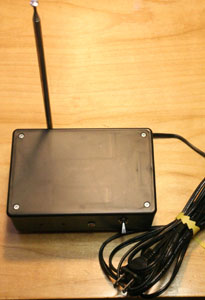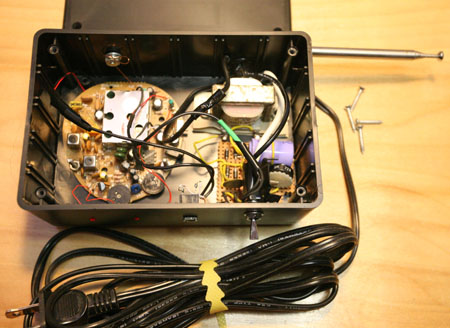|
 3-Way High Efficiency Speaker
3-Way High Efficiency Speaker
(Lavoce, Dynaudio, Foster 3-way. October-2023)
 LCR MTM 3-Channel Speaker
LCR MTM 3-Channel Speaker
(Three MTM Speakers in One. July-2023)
 Mini7bt - A Minimus 7 Portable Bluetooth Speaker
Mini7bt - A Minimus 7 Portable Bluetooth Speaker
(Minimus 7 and Dayton Audio. Spring-2022)
 2-Way Ribbon Tweeter Speakers
2-Way Ribbon Tweeter Speakers
(Vifa and Pioneer. May-2020)
 Transmission Line Speakers
Transmission Line Speakers
(Aborted attempt at a TL. September-2012)
 Acoustic Research AR-4x Rehab
Acoustic Research AR-4x Rehab
(Rehab of a garage sale find. January-2016)
 Infinity RS-4000 Rehab
Infinity RS-4000 Rehab
(Rehab of a garage sale find. June-2015)
 Polaris
Polaris
(A tall, thin, upwards firing omnidirectional speaker. May-2010)
 Shiva_PR15
Shiva_PR15
(A powered subwoofer using a 12" driver and 15" passive radiator. Jan-2010)
 Can-Less
Can-Less
(A computer speaker; redux. December-2005)
 Can-Can
Can-Can
(A computer speaker in a light canister. Jan-2005)
 Sonosub
Sonosub
(10" vented subwoofer in a cardboard tube, powered by a Parapix amp. May-1999)
 MTM Center Channel Speaker
MTM Center Channel Speaker
(A Madisound design. Nov-1997)
 2-way Surround Speakers
2-way Surround Speakers
(5" woofer and 1" tweeter. July 1997)
 3-piece mini system
3-piece mini system
(6" DVC bass module mated to 4" car speaker. June 1997)
 3-way Vented Floorstanding Speaker
3-way Vented Floorstanding Speaker
(vented 10" woofer, 5" mid and 1" tweeter in a 4
ft tower. Summer 1995)
 NHT1259 Subwoofer
NHT1259 Subwoofer
(A 12" woofer in a sealed architectural pedestal. Winter 1994-95)
 Inexpensive Speaker Stands
Inexpensive Speaker Stands
(Particle board, sand and spray paint. Fall 1994)
 2-way satellite
2-way satellite
(6.5" woofer and 1" tweeter. Summer/Fall 1994)
| Audio Electronics Related Projects |
 900 MHz Audio Receiver
900 MHz Audio Receiver
(Better use for bad headphones. Jan-2008)
 Buster - A Simple Guitar Amp
Buster - A Simple Guitar Amp
(Perfect for the beginner. Jan-2010)
 A PC-based Audio Console
A PC-based Audio Console
(Use a PC to play tunes. Jan-2010)
 LM-12 Amp
LM-12 Amp
(Bridged LM-12 opamps. Aug-2003)
 CeeDeePee
CeeDeePee
(A CD player and FM tuner from spare computer parts. Oct-2002)
 Quad 2000 4-Channel Amp
Quad 2000 4-Channel Amp
(Premade modules by Marantz. May-1998)
 Zen Amp and Bride of Zen Preamp
Zen Amp and Bride of Zen Preamp
(by Nelson Pass. Apr-1997)
 Using Wood in Speakers FAQ
Using Wood in Speakers FAQ
(Work in progress)
 MDF FAQ for speaker builders
MDF FAQ for speaker builders
 Woodworking Tools for the DYIer
Woodworking Tools for the DYIer
(HomeTheaterHiFi.com Oct-1998)
 Some Thoughts on Cabinet Finished for DIY Speakers
Some Thoughts on Cabinet Finished for DIY Speakers
 Large Grills Made Easy
Large Grills Made Easy
 Some Parts Suppliers
Some Parts Suppliers
(Outdated)
 DIY Audio Related URLs
DIY Audio Related URLs
 Veneering Primer
Veneering Primer
(by Keith Lahteine)
 How to get a Black Piano Finish
How to get a Black Piano Finish
(by DYI Loudspeaker List members)
 Sonotube FAQ
Sonotube FAQ
(by Gordon McGill)
 Excerpts from the Bass List
Excerpts from the Bass List
(Oldies but Goodies)
 DIY Loudspeaker List Archives
DIY Loudspeaker List Archives
|
|
900 MHz Receiver
I hate throwing things out that
aren't broken. Not only does it add to the landfill but it just seems like such a
huge waste. Take this little project from 2008 for instance.
Years ago, I bought a set of
900 MHz stereo headphones. These were branded by Emerson but I've seen lots of
others over the years. I used them in my office, and they worked - had plenty
of range. They had one really serious problem - they were just plain uncomfortable.
Despite all the electronics to make the sound decent, the design didn't handle
the comfort factor. The more I wore them, the less I wanted to. In the end, I
stopped using them entirely.
Well, I was all set to get
rid of them when it occured to me that I can re-purpose this as a wireless
transmitter/receiver pair. While the sound is not perfect - there's some
amount of hiss - it's not bad for casual use. What if I could use this in a
powered speaker for outdoor use? Or maybe hook up the transmitter to a PC
playing MP3s and listening over the receiver in another room?
I tossed all sorts of
ideas around for some time, but many of them required me to build something
else to go with it. In the end, I decided to simply re-package the receiver
into something useful. I can always append to it as needed in the future.
So here's what things look like today. First the transmitter.

The transmitter was left
untouched. This alien looking device comes with a wall-wart and a 1/8 inch
stereo cable designed for a stereo headphone jack. It also has a small cord to
recharge the batteries in the old headphones - this is now unused. The receiver looks like
this:


The box is
just a plastic case from my local
Radio Shack. On the
rear is the power cord and an antenna from my parts box. The front panel has
a 2 red LEDs (signal lock and power), an 1/8 inch stereo output jack and a
power switch. The bottom has four stick-on rubber feet. The device was
originally designed to drive 32 ohm headphones. In this configuration,
it's more than capable of driving the input an amplifier. Now for a view
of the interior:

The are
three obvious parts. On the upper right is a small 6.3v 300mA transformer.
On the bottom right is a small power supply. This LM317 based supply takes
the AC power, converts it to DC and reduces it to about 2.5v. The original
headphones were powered by two 1.2 volt NiCd batteries housed on the left
ear cup and would recharge via the transmitter. I simply matched the voltage
of those batteries.
The guts are
on the left. The oval shaped circuit board used to sit on the right ear cup.
The two LEDs were originally located on the PCB; they are now epoxied to the
front of the box. The volume and tuning are preset and I've given no access
to them from the outside. From testing, this has not been a problem. I can always adjust the
tuning on the transmitter side if necessary; and the volume is set near max.
So that's it
for now. I've tested the setup and it works well. I still need to put it to actual
use but that's another chapter for another time.
|
07-January-2010
Note: The
contents in these pages are provided without any guarantee,
written or implied. Readers are free to use them at their
own risk, for personal use only. No commercial use is allowed
without prior written consent from the author. |
|
 |